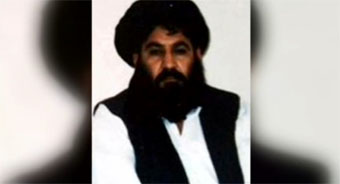
Image courtesy of Reuters
U.S. Drone Strike Kills Taliban Chief
| published May 22, 2016 |
By Keith H. Roberts, Thursday Review staff
Top officials with the government of Afghanistan confirm that one of the Taliban’s top leaders is dead, the apparent target of a U.S. drone strike in western Pakistan.
Afghan government chief operating officer Abdullah Abdullah confirmed that one-time emir and Mullah Akhtar Mansour was killed over the weekend after a carefully orchestrated operation which included both on-the-ground intelligence, as well as satellite and drone surveillance.
Abdullah said that Mansour was killed in Quetta, Pakistan, in the Baluchistan Province not far from the border of Afghanistan. Though there had been a flurry of media reports on the possible death of Mansour, neither the Pentagon, nor the White House have confirmed anything other than a high-ranking Taliban official had been targeted by drone strikes on Saturday night. Abdullah’s comments early Sunday came as the first official confirmation of Mansour’s assassination.
The Taliban has not commented so far on word of Mansour’s killing. Some media agencies are reporting, however, that the intelligence services of both Afghanistan and Pakistan are privately confirming Mansour’s death.
U.S. military and intelligence officials had made Mansour’s death a priority for months. And both the State Department and the White House have stressed Mansour’s deep importance to the operations of the Taliban in both Afghanistan and Pakistan. As recently as Saturday and Sunday Secretary of State John Kerry has emphasized Mansour’s “eminent threat” to the stability of the region. Mansour was instrumental in the strategic operations of both the Taliban and al Qaeda.
Though not confirming anything about Mansour’s death, Kerry did say that government officials in both Afghanistan and Pakistan had been notified that the drone operations against Mansour were rapidly coming to a head, and that his death might be eminent. Kerry said that both governments had talked via telephone in the hours before the drone strikes were conducted.
“Peace is what we want,” Kerry said. “Mansour was a threat to that [peace] effort, and to bringing an end to the violence and suffering the people of Afghanistan have endured for so many years.”
Reuters is reporting that the drone strike, which took place late Saturday, was authorized by President Obama shortly before the operation was set in motion.
Intelligence experts and terrorism analysts suggest that the death of Mansour may precipitate a power struggle among the Taliban top leadership. A likely successor to Mansour would be Sirajuddin Haqqani, ad hoc chief of a terror network blamed for numerous violent attacks, including dozens of recent car bombings in Kabul and in other Afghan cities and towns. Haqqani’s rise to the top post of the Taliban may signal an increase in extreme violence in the region, especially as the Taliban seeks to outflank Syria-based ISIS as the chief antagonist on behalf of radical Islamic jihad and control of the narrative of Islamic State extremism.
Another concern: though the U.S. communicated with Pakistan prior to the drone strike was concluded, it is not clear that officials in Islamabad agreed wholeheartedly with the attack by U.S. drones in Pakistani territory. Some U.S. officials—along with the U.S.-backed government in Kabul—have long accused Pakistan of harboring Taliban enclaves and key al Qaeda operations within its borders.
The drone strike, though a victory for the U.S., may prove to be problematic for relations between Pakistan and the United States. Pakistan has frequently complained about U.S. drone strikes within its borders, though it sometimes quietly approves of the attacks if they happen to align with the interests of Islamabad.
Related Thursday Review articles:
Stolen Documents Show ISIS Wants Upper Hand in Recruiting; R. Alan Clanton, Thursday Review; April 18, 2016
